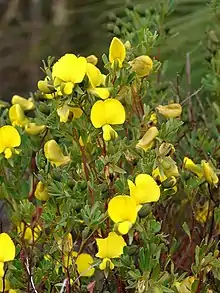| Leafy wedge pea | |
|---|---|
 | |
| Gompholobium virgatum in Noosa National Park | |
| Scientific classification | |
| Kingdom: | Plantae |
| Clade: | Tracheophytes |
| Clade: | Angiosperms |
| Clade: | Eudicots |
| Clade: | Rosids |
| Order: | Fabales |
| Family: | Fabaceae |
| Subfamily: | Faboideae |
| Genus: | Gompholobium |
| Species: | G. virgatum |
| Binomial name | |
| Gompholobium virgatum | |
| Synonyms[1] | |
| |
Gompholobium virgatum, commonly known as leafy wedge pea,[2] is a species of flowering plant in the family Fabaceae and is endemic to eastern Australia. It is an erect or sprawling shrub with trifoliate leaves, the leaflets narrow egg-shaped with the narrower end towards the base, and yellow and greenish, pea-like flowers.
Description
Gompholobium virgatum is an erect or sprawling shrub that typically grows up to 2 m (6 ft 7 in) high and 1 m (3 ft 3 in) wide. The leaves are trifoliate, the leaflets narrow egg-shaped with the narrower end towards the base, 7.5–20 mm (0.30–0.79 in) long and about 0.8–4.3 mm (0.031–0.169 in) wide with the edges curved down. The flowers are arranged singly, in pairs or threes, each flower on a pedicel 8.5 mm (0.33 in) long. The sepals are 5.2–7.2 mm (0.20–0.28 in) long, the standard petal and wings are yellow and the keel is greenish-yellow. Flowering occurs throughout the year and the fruit is an oval pod 7–10 mm (0.28–0.39 in) long.[2][3]
Taxonomy and naming
Gompholobium virgatum was first formally described in 1825 by Augustin Pyramus de Candolle in Prodromus Systematis Naturalis Regni Vegetabilis, from an unpublished description by Franz Sieber.[4][5] The specific epithet (virgatum) means "virgate".[6]
Distribution and habitat
Leafy wedge pea grows in heathland, woodland and open forest on the coast and tablelands from southern Queensland to southern New South Wales.[2][3]
References
- 1 2 "Gompholobium virgatum". Australian Plant Census. Retrieved 6 September 2021.
- 1 2 3 "Gompholobium virgatum". Royal Botanic Garden Sydney. Retrieved 6 September 2021.
- 1 2 Wood, Betty. "Gompholobium virgatum". Lucid Keys. Retrieved 3 September 2021.
- ↑ "Gompholobium virgatum". APNI. Retrieved 6 September 2021.
- ↑ de Candolle, Augustin P. (1825). Prodromus Systematis Naturalis Regni Vegetabilis. Vol. 2. Paris. p. 105. Retrieved 6 September 2021.
- ↑ Sharr, Francis Aubi; George, Alex (2019). Western Australian Plant Names and Their Meanings (3rd ed.). Kardinya, WA: Four Gables Press. p. 336. ISBN 9780958034180.